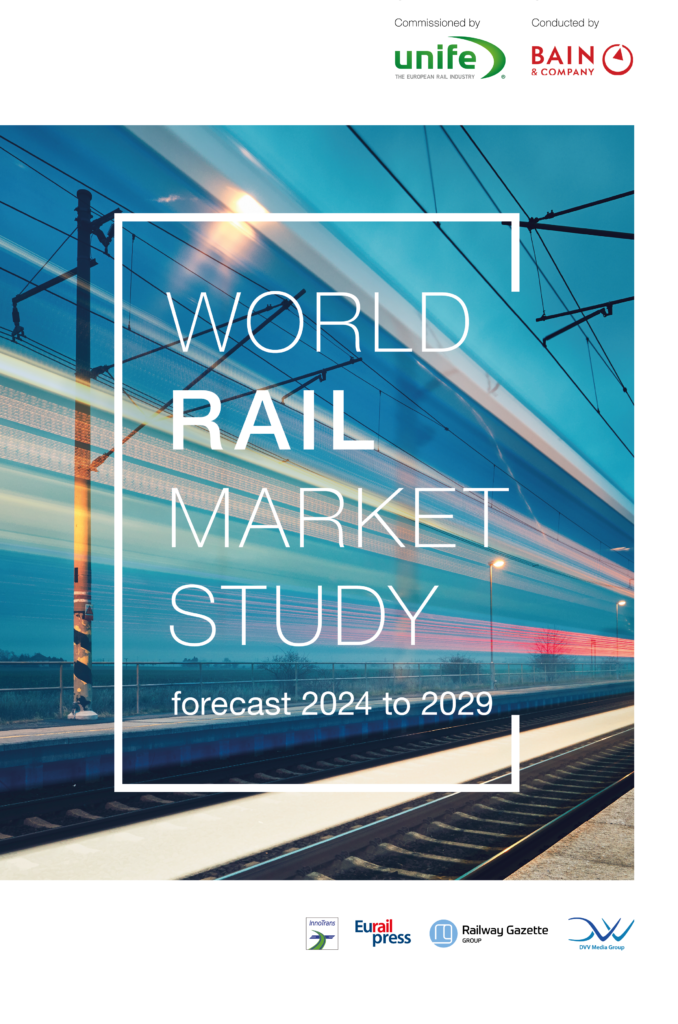Policymakers and industry give vote of confidence as global rail supply market continues to expand despite geopolitical tensions
With strong political and financial backing from both public and private sectors, the 10th edition of the World Rail Market Study has confirmed the global rail supply market grew 2.7% annually between 2021 and 2023, while also projecting a positive forecast for the rest of the decade.
In the face of rising geopolitical tensions, the global rail supply market took advantage of growing transport demand and the ongoing green transition, booming to an average annual volume of €201.8 billion (adjusted for inflation), which is up from €176.5 billion as recorded in the 9th edition of the World Rail Market Study in 2022 (covering the years 2019-2021).
Between 2021-2023 and 2027-2029, the global market is expected to grow by 3% annually in real terms. By the end of this period, the average market size is expected to expand to €240.8 billion per year.
This growth – which is forecasted and based on over 10,000 future rail project orders, including greenfield investments, replacements, and modernisation projects – comes in the face of rising protectionism, as accessibility to global markets for the EU rail suppliers on average fell from 60% to 59% for the 2021-2023 period.
The non-accessible parts of the market include in-house production and countries with protective trade barriers and strong domestic preferences, showing a long term trend away from open markets, with each perecent pont less representing billions of Euros of opportunities lost for the European Rail Supply Industry.
In the 2021-2023 period, the European Union and the United States deployed large investments to both support economic recoveries in the aftermath of the pandemic and accelerate the green transition.
The growth in the global rail supply market was largely driven by Western Europe, which grew by 7.3% per year. This growth took place across the entire value chain, with some of the strongest growth areas including electric multiple units (EMUs), infrastructure investments for light rail and investments in the European Rail Traffic Management System (ERTMS) trackside and onboard systems.
Other strong performers included Africa and the Middle East, with a growth rate of 10.2% per year, while Eastern Europe grew 6.8% per year and North America grew 3.8% per year.
Prolonged COVID-19 lockdowns and financial challenges among local governments and railway operators caused a 1.2% decline per year in Asia Pacific, although it remained the largest region in demand.
During 2021 and 2023, there was substantial global investment in rolling stock (excluding coaches and freight cars). The installed base in this period grew by 5.1%. Elsewhere, metro vehicles increased by 7.5%, light rail vehicles by 5.9%. Finally, very high-speed trains were proven to be popular, where units grew by 7.0% and high-speed trains by 5.0%.
Positive market development in the rail supply industry is driven by several factors, including urbanisation, digitalisation, and sustainability. These factors enhance the demand for transportation, boost railways‘ competitiveness, and make rail investments a pressing policy priority due to their low environmental footprint.
The World Rail Market Study was produced with the support of Bain & Company, examining 66 countries which account for 99% of global rail traffic and the full rail supply value chain, including infrastructure, rail control, rolling stock, services, and turnkey management.
This and other exclusive, high-quality information can only be found in the full version of the World Rail Market Study 2024, which is available from the DVV Media Shop in both online and physical copy formats.
Quotes attributable to UNIFE Director General Enno Wiebe
“Despite an unpredictable world and the highest inflation for decades, strong public and private investment and a positive future forecast shows how reselient the rail supply industry is.”
“Even though there is a positive forecast, there is more work to be done. By reducing unnecessary red tape and ensuring a stable regulatory enviroment for the European Rail Supply Industry, it is possible to exceed these expectations.”
Quotes attributable to Bain & Company Partner Massimo Sabella
“Digitalisation continues to expand its impact across the entire rail value chain, with the potential to unlock significant efficiency improvements, enhance services, and reduce costs substantially.
“The rail sector's resilience is clear – despite global challenges – the industry is set to grow by over €40 billion annually by 2029. The decline in market accessibility highlights an emerging concern as some rail markets, especially outside Europe, are becoming more protectionist."
For more information regarding the 10th edition of the World Rail Market Study, please contact:
Carlos Corts
Public Affairs Manager, UNIFE
carlos.corts@unife.org
+32 2 642 23 20
